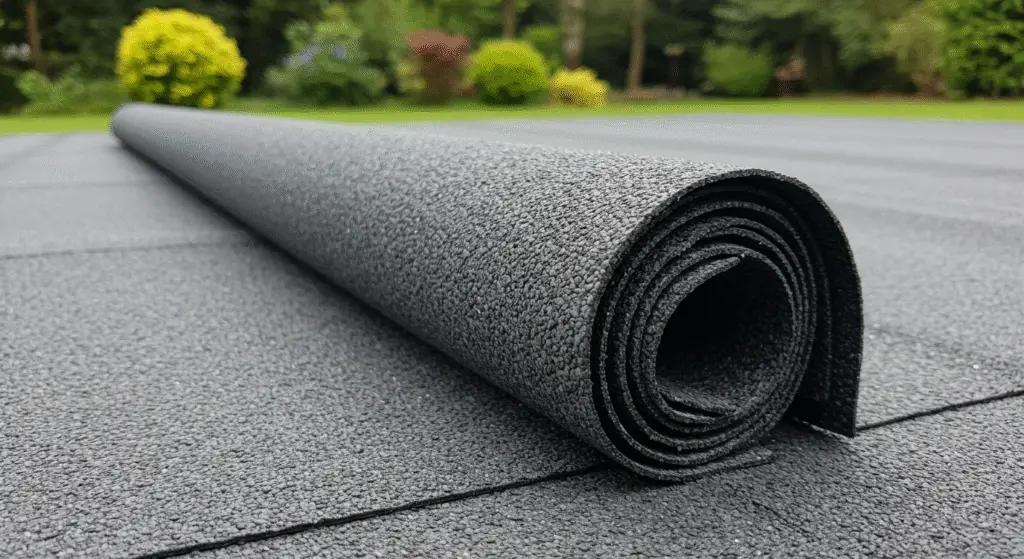
If you’re looking for a simple and budget-friendly way to cover a roof, you might be wondering what is rolled roofing. This type of roofing material is often used for sheds, garages, and other small buildings. It’s easy to install, doesn’t cost much, and can protect your roof from rain, wind, and sunlight.
In this blog post, we’ll explain what rolled roofing is, how it works, where it’s best used, and what to keep in mind before choosing it for your project.
What Is Rolled Roofing and Why People Use It
So, what is rolled roofing? Rolled roofing is a roofing material that comes in large rolls, usually made from the same material as asphalt shingles. It’s called “rolled” because it’s rolled out across the roof during installation. Each roll can cover a wide area, making the process fast and easy.
People choose this option because it’s much cheaper than regular shingles, and you can even install it yourself if you’re handy with basic tools. It’s great for flat or low-slope roofs and works best on small buildings that don’t need a fancy look.
What It’s Made Of
Rolled roofing is usually made of asphalt, fiberglass, or rubber. The top layer is covered in small stone granules to protect against weather, and the bottom is smooth, sometimes covered with a thin layer of sand or talc so it doesn’t stick to itself in the roll.
It’s flexible, lightweight, and easy to handle, even for beginners.
Different Types Available
There are a few different kinds of rolled roofing to choose from. The most common one is called mineral surfaced roofing. It’s strong enough to stand up to wind and rain, and it’s what you’ll find at most hardware stores.
There are also rubber types made from recycled materials. These are better for the environment and are a little more flexible, which can help with cracks or movement on the roof. Another kind is felt-based roofing, which is often used under other roofing layers or as a short-term solution.
Main Benefits
One of the biggest reasons people ask what is rolled roofing is because they need something fast, cheap, and simple. Here are some clear benefits:
- It’s low-cost, often the cheapest roofing option available.
- Installation is fast—you can do a whole shed roof in one day.
- It doesn’t need many tools or supplies.
- It’s lightweight and won’t add pressure to the roof structure.
It’s a good choice for temporary or small building roofs.
How to Install It
Installing rolled roofing is usually a simple job. First, clean your roof and make sure it’s dry. Then apply roofing cement to the bottom layer or seams. Roll out the roofing material starting at one end. Nail it down along the edges and in the middle. Overlap the next roll slightly so no water can sneak through.
Some people like to add a waterproof seal or an extra coat on top to make it last longer. If you take your time and follow the steps, you can do this project without hiring a contractor.
Things to Think About Before You Buy
Now that you know what rolled roofing is, it’s also good to understand its downsides. Rolled roofing doesn’t last as long as shingles. Most of the time, it will need replacing after 5 to 10 years.
It also doesn’t look very pretty. If you’re putting a roof on your house or a front-facing building, you might want something more stylish. And, it only works well on flat or low-sloped roofs. It’s not made for steep angles.
Best Places to Use It
This type of roofing is perfect for small, low-cost buildings. Some good places to use it include:
- Garden sheds
- Tool storage units
- Garages
- Barns
- Mobile homes or trailers
- Flat-roofed porches or patio covers
These are places where you want to keep things dry but don’t need an expensive or fancy-looking roof.

Rolled Roofing vs. Shingles
You might wonder if it’s better to use rolled roofing or shingles. Here’s a quick comparison:
- Rolled roofing is cheaper and quicker to install.
- Shingles look better and last longer.
- Rolled roofing is good for small, flat surfaces.
- Shingles work better for homes and sloped roofs.
It really depends on what kind of building you’re working on and how long you want the roof to last.
Tips to Make It Last Longer
If you decide to use rolled roofing, you’ll want it to last as long as possible. Here are some helpful tips:
- Clean off leaves, sticks, or dirt regularly.
- Look for cracks or damage after big storms.
- Seal any gaps right away with roofing cement.
- If possible, add a protective top coat for extra weather protection.
Taking care of your roof, even a simple one, helps you avoid costly repairs later.
Is It the Right Choice?
Whether or not rolled roofing is right for you depends on your needs. If you’re roofing a small building on a tight budget, it can be a great choice. It’s easy to install, gets the job done quickly, and protects your structure from the elements.
But if you want something long-lasting or attractive, you may want to explore other options. Still, for many people, especially DIYers or those with outbuildings, it’s the best solution.
Final Thoughts
Now you have a clear answer to the question: what is rolled roofing? It’s a simple, cost-effective material that’s great for small and low-slope roofs. While it may not last as long as other types of roofing, it’s quick to install, easy to maintain, and very affordable.
If you’re working on a garage, workshop, or backyard shed, it’s worth considering. Just be sure to weigh the pros and cons, and always follow safety tips during installation.
